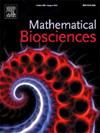Biological pattern formation in cell dynamics under cross-diffusion: An Isogeometric analysis perspective
IF 1.8
4区 数学
Q2 BIOLOGY
引用次数: 0
Abstract
This note presents an efficient numerical method based on isogeometric analysis (IgA) and an operator splitting approach for solving nonlinear reaction–diffusion systems with cross-diffusion. Such problems are often used in mathematical modeling of developmental biology and are subject to highly rigid reactive and diffusive terms. Similarly, the interactions between substances produce complex morphologies (Roth, 2011) [1]. In this note we present two different types of solutions. Mainly, the Turing patterns and the traveling waves, which are a direct result of the presence of linear diffusion and/or cross-diffusion in the dynamical system. To deal with the multiphysical nature of the nonlinear system, we propose a time-splitting method. The spatial discretization is performed using IgA-based Non-Uniform Ratinal B-spline (NURBS) functions, where the semidiscrete problem is integrated using an implicit scheme. The nonlinear terms are treated by an adaptive fourth-order Runge–Kutta method. The well-known FitzHugh–Nagumo and Gray–Scott models are used to study the performance of the new method. The results obtained demonstrate the ability of our algorithm to accurately maintain the shape of the solution in the presence of complex patterns arising from biological cells on complex geometries. Furthermore, the energy dissipation in the Allen-Cahn equation is analyzed and the new method clarifies the effect of the geometry on the formed patterns and on the energy decay for the considered benchmarks.
交叉扩散下细胞动力学中的生物模式形成:等几何分析视角
本文提出了一种基于等几何分析的求解交叉扩散非线性反应扩散系统的有效数值方法和算子分裂方法。这类问题经常用于发育生物学的数学建模,并且受制于高度刚性的反应性和扩散性术语。同样,物质之间的相互作用也会产生复杂的形态(Roth, 2011)。在本文中,我们将介绍两种不同类型的解决方案。主要是图灵模式和行波,它们是动力系统中线性扩散和/或交叉扩散的直接结果。为了处理非线性系统的多物理性质,我们提出了一种时间分裂方法。采用基于iga的非均匀b样条(NURBS)函数进行空间离散化,其中半离散问题采用隐式格式进行积分。非线性项采用自适应四阶龙格-库塔法处理。使用FitzHugh-Nagumo和Gray-Scott模型研究了新方法的性能。得到的结果表明,我们的算法能够在复杂几何形状上的生物细胞产生的复杂图案存在的情况下准确地保持溶液的形状。此外,还分析了Allen-Cahn方程中的能量耗散,阐明了几何形状对所考虑基准的形成模式和能量衰减的影响。
本文章由计算机程序翻译,如有差异,请以英文原文为准。
求助全文
约1分钟内获得全文
求助全文
来源期刊

Mathematical Biosciences
生物-生物学
CiteScore
7.50
自引率
2.30%
发文量
67
审稿时长
18 days
期刊介绍:
Mathematical Biosciences publishes work providing new concepts or new understanding of biological systems using mathematical models, or methodological articles likely to find application to multiple biological systems. Papers are expected to present a major research finding of broad significance for the biological sciences, or mathematical biology. Mathematical Biosciences welcomes original research articles, letters, reviews and perspectives.
 求助内容:
求助内容: 应助结果提醒方式:
应助结果提醒方式:


